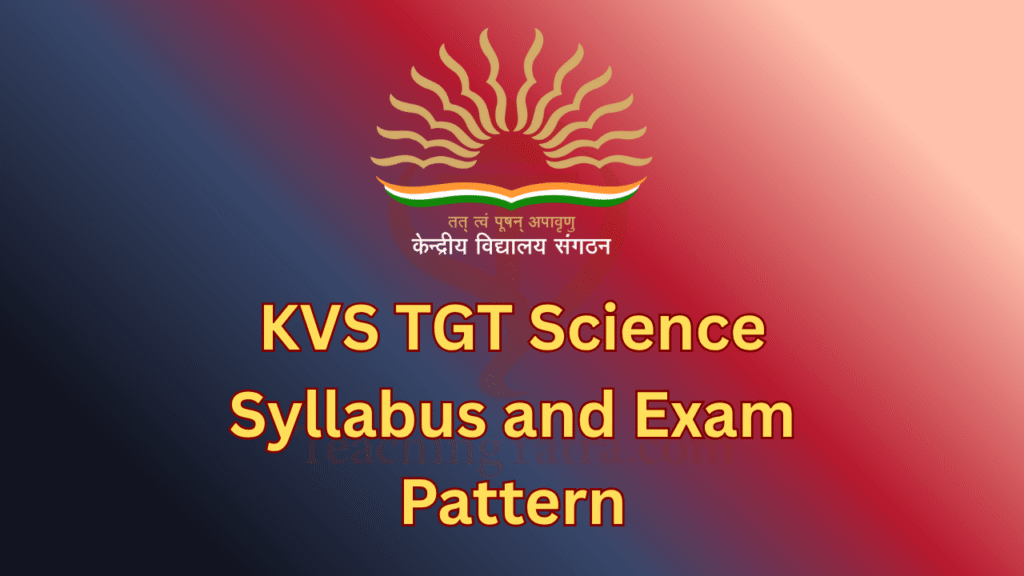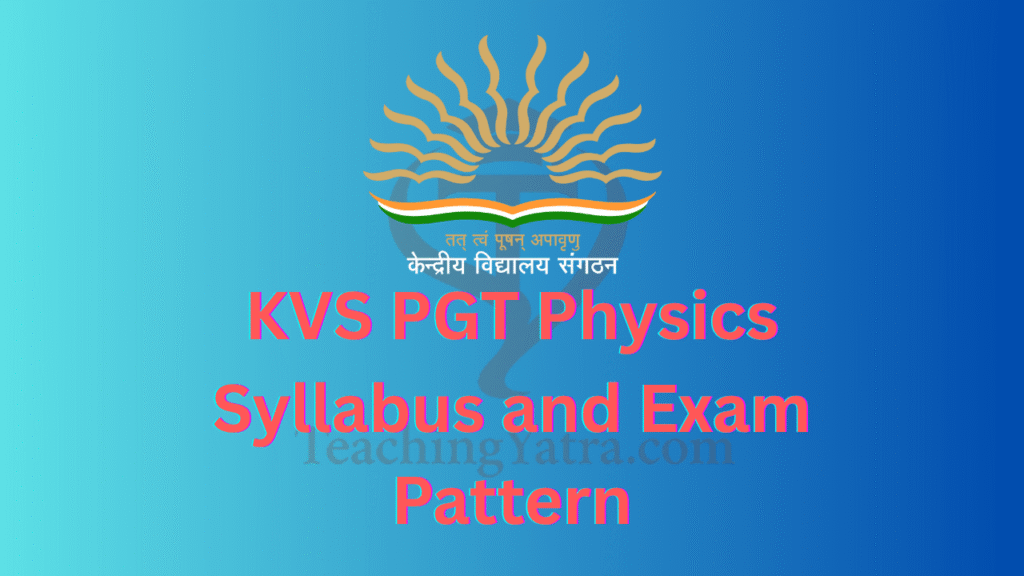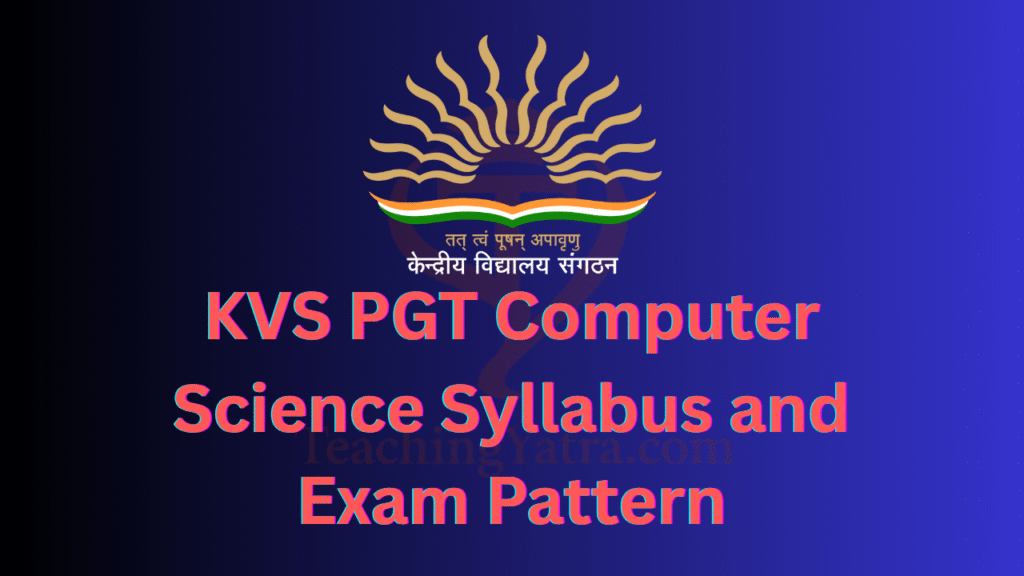
The KVS TGT Science Syllabus and Exam Pattern 2025 provides a complete guide for candidates preparing for the Trained Graduate Teacher (Science) post under Kendriya Vidyalaya Sangathan. Understanding the detailed syllabus and exam structure is essential to plan your preparation effectively. This article covers the subject-wise topics, marking scheme, and exam format to help aspirants prepare in a focused and organized manner for the upcoming KVS TGT Science exam.
Table of Contents
KVS TGT Science Syllabus 2025: Overview
The KVS TGT Science Syllabus 2025 is designed for candidates applying for the Trained Graduate Teacher (Science) post. It covers key topics from Physics, Chemistry, and Biology. Understanding the syllabus and exam pattern is important for planning your preparation effectively.
The exam consists of 180 multiple-choice questions for 180 marks to be completed in 3 hours. It is divided into four parts:
- Part I: General English and General Hindi (10 marks each)
- Part II: General Awareness, Reasoning, and Computer Literacy (20 marks total)
- Part III: Perspectives on Education and Leadership (40 marks)
- Part IV: Subject Concerned – Science (100 marks)
The science section includes topics like mechanics, electricity, atoms, cells, physiology, ecology, and more. There is no negative marking. This exam pattern helps candidates prepare in a focused and organized way.
KVS TGT Science Exam Pattern 2025
The KVS TGT Science Exam 2025 consists of 180 multiple-choice questions carrying a total of 180 marks, to be completed in 3 hours. The exam is structured into four parts. Part I evaluates language proficiency through General English and General Hindi. Part II checks the candidate’s General Awareness, Reasoning Ability, and Computer Literacy. Part III focuses on Perspectives on Education and Leadership. Part IV tests the candidate’s subject knowledge in Science, which includes topics from Physics, Chemistry, and Biology. The exam is bilingual (English and Hindi) and aims to assess both teaching aptitude and subject expertise.
KVS TGT Science Exam Pattern & Marks Distribution
| Part | Subject | No. of Questions | Marks |
|---|---|---|---|
| Part I | General English | 10 | 10 |
| General Hindi | 10 | 10 | |
| Part II | General Awareness & Current Affairs | 10 | 10 |
| Reasoning Ability | 5 | 5 | |
| Computer Literacy | 5 | 5 | |
| Part III | Perspectives on Education & Leadership | 40 | 40 |
| Part IV | Subject Concerned (Science) | 100 | 100 |
| Total | 180 | 180 |
Detailed KVS TGT Science Syllabus 2025
Subject specific syllabus includes the concepts of NCERT/CBSE syllabus and Text Books (Classes VI to X), however, the questions will be testing the depth of understanding and application of these concepts at the level of Graduation.
Matter – Nature and Behaviour
Definition of matter; solid, liquid and gas; characteristics – shape, volume, density; change of state – melting (absorption of heat), freezing, evaporation (cooling by evaporation), condensation, sublimation.
Nature of matter
Elements, compounds and mixtures. Heterogeneous and homogeneous mixtures, colloids and suspensions. Physical and chemical changes (excluding separating the components of a mixture).
Particle nature and their basic units
Atoms and molecules, Law of Chemical Combination, Chemical formula of common compounds, Atomic and molecular masses.
Structure of atoms
Electrons, protons and neutrons, Valency, Atomic Number and Mass Number, Isotopes and Isobars.
Chemical reactions
Chemical equation, Balanced chemical equation, implications of a balanced chemical equation, types of chemical reactions – combination, decomposition, displacement, double displacement, precipitation, endothermic and exothermic reactions, oxidation and reduction.
Acids, bases and salts
Their definitions in terms of furnishing of H⁺ and OH⁻ ions, general properties, examples and uses, neutralization, concept of pH scale (definition relating to logarithm not required), importance of pH in everyday life; preparation and uses of Sodium Hydroxide, Bleaching powder, Baking soda, Washing soda and Plaster of Paris.
Metals and nonmetals
Properties of metals and non-metals; Reactivity series; Formation and properties of ionic compounds; Basic metallurgical processes; Corrosion and its prevention.
Carbon compounds
Covalent bonding in carbon compounds, versatile nature of carbon, homologous series, nomenclature of carbon compounds containing functional groups (halogens, alcohols, ketones, aldehydes, alkanes and alkynes), difference between saturated and unsaturated hydrocarbons, chemical properties of carbon compounds (combustion, oxidation, addition and substitution reaction), ethanol and ethanoic acid (only properties and uses), soaps and detergents.
Cell – Basic Unit of Life
Cell as a basic unit of life; prokaryotic and eukaryotic cells, multicellular organisms; cell membrane and cell wall, cell organelles and cell inclusions – chloroplast, mitochondria, vacuoles, endoplasmic reticulum, Golgi apparatus; nucleus, chromosomes – basic structure, number.
Subject-specific syllabus includes concepts from NCERT/CBSE textbooks (Classes VI to X); however, questions will test the depth of understanding and application at the graduation level.
Tissues, Organs, Organ System, Organism
Structure and functions of animal and plant tissues (only four types of tissues in animals; Meristematic and Permanent tissues in plants).
Life processes
‘Living Being’. Basic concepts of nutrition, respiration, transport and excretion in plants and animals.
Control and co-ordination in animals and plants
Tropic movements in plants; introduction of plant hormones; control and coordination in animals: Nervous system, voluntary, involuntary and reflex actions, chemical coordination: animal hormones.
Reproduction
Reproduction in animals and plants (asexual and sexual), reproductive health – need and methods of family planning, safe sex vs HIV/AIDS, childbearing and women’s health.
Heredity and Evolution
Heredity; Mendel’s contribution – laws of inheritance of traits, sex determination, brief introduction to evolution.
Motion
Distance and displacement, velocity; uniform and non-uniform motion along a straight line; acceleration, distance-time and velocity-time graphs for uniform motion and uniformly accelerated motion, elementary idea of uniform circular motion.
Force and Newton’s laws
Force and Motion, Newton’s Laws of Motion, action and reaction forces, inertia of a body, inertia and mass, momentum, force and acceleration.
Gravitation
Gravitation; Universal Law of Gravitation, force of gravitation of the earth (gravity), acceleration due to gravity; mass and weight; free fall.
Floatation
Thrust and pressure, Archimedes’ Principle, buoyancy.
Work, Energy and Power
Work done by a force, energy, power; kinetic and potential energy; law of conservation of energy.
Sound
Nature of sound and its propagation in various media, speed of sound, range of hearing in humans; ultrasound; reflection of sound; echo.
Effects of current
Electric current, potential difference and electric current, Ohm’s law, resistance, resistivity, factors affecting resistance of a conductor, series and parallel combination of resistors and applications, heating effect of electric current and applications, electric power, interrelation between P, V, I and R.
Magnetic effects of current
Magnetic field, field lines, field due to a current-carrying conductor, coil or solenoid; force on current-carrying conductor, Fleming’s Left-Hand Rule, electric motor, electromagnetic induction, induced potential difference and current, Fleming’s Right-Hand Rule, electric generator, direct current, alternating current – frequency of AC, advantages of AC over DC, domestic electric circuits.
Food production
Plant and animal breeding and selection for quality improvement and management; use of fertilizers and manures; protection from pests and diseases; organic farming.
Natural phenomena
Reflection of light by curved surfaces; images formed by spherical mirrors, centre of curvature, principal axis, principal focus, focal length, mirror formula (no derivation), magnification. Refraction – laws of refraction, refractive index, refraction of light by spherical lenses, image formation, lens formula (no derivation), magnification, power of a lens, human eye functioning, defects of vision and correction, applications of mirrors and lenses, prism, dispersion, scattering of light, daily life applications.
Our environment
Ecosystem, environmental problems, ozone depletion, waste production and solutions, biodegradable and non-biodegradable substances.
Detailed KVS TGT Science Syllabus 2025 in Hindi
पदार्थ – प्रकृति और व्यवहार
पदार्थ की परिभाषा; ठोस, द्रव और गैस; विशेषताएँ – आकार, आयतन, घनत्व; अवस्थाओं में परिवर्तन – वलयन (ऊष्मा का अवशोषण), जमना, वाष्पीकरण (वाष्पीकरण द्वारा शीतलन), संघनन, उदातन।
पदार्थ की प्रकृति
तत्त्व, यौगिक और मिश्रण। विषम और सममिश्रण, कोलॉयड और निलंबन। भौतिक और रासायनिक परिवर्तन (मिश्रण के घटकों को पृथक करना शामिल नहीं है)।
कण की प्रकृति और उनकी मूल इकाइयाँ
परमाणु और अणु, रासायनिक संयोग के नियम, सामान्य यौगिकों के रासायनिक सूत्र, परमाणु और अणु भार।
परमाणु की संरचना
इलेक्ट्रॉन, प्रोटॉन और न्यूट्रॉन, संयोजकता, परमाणु क्रमांक और द्रव्यमान क्रमांक, समस्थानिक और समभारिक।
रासायनिक अभिक्रियाएँ
रासायनिक समीकरण, संतुलित रासायनिक समीकरण, संतुलित समीकरण के प्रभाव, रासायनिक अभिक्रियाओं के प्रकार – संयोजन, अपघटन, विस्थापन, द्विस्थापन, अवक्षेपण, ऊष्माक्षेपी और ऊष्माक्षेपी अभिक्रियाएँ, ऑक्सीकरण और अपचयन।
अम्ल, क्षार और लवण
H⁺ और OH⁻ आयनों की उपस्थिति के आधार पर परिभाषा, सामान्य गुण, उदाहरण और उपयोग, उदासीनीकरण, pH पैमाने की अवधारणा (लघुगणक की परिभाषा आवश्यक नहीं), दैनिक जीवन में pH का महत्व; सोडियम हाइड्रॉक्साइड, ब्लीचिंग पाउडर, बेकिंग सोडा, वॉशिंग सोडा और प्लास्टर ऑफ पेरिस की तैयारी और उपयोग।
धातु और अधातु
धातुओं और अधातुओं के गुण, अभिक्रियाशीलता श्रेणी, आयनिक यौगिकों की संरचना और गुण, मूल धातुकर्मीय प्रक्रियाएँ, संक्षारण और इसकी रोकथाम।
कार्बन यौगिक
कार्बन यौगिकों में सहसंयोजक बंध, कार्बन की बहुगुणता, समजात श्रेणी, कार्यात्मक समूह वाले यौगिकों का नामकरण (हैलोजन, अल्कोहल, कीटोन, एल्डीहाइड, अल्केन, एल्काइन), संतृप्त और असंतृप्त हाइड्रोकार्बन में अंतर, रासायनिक गुण (दहन, ऑक्सीकरण, योग और प्रतिस्थापन), एथेनॉल और एथेनॉइक अम्ल (गुण और उपयोग), साबुन और डिटर्जेंट।
कोशिका – जीवन की मूल इकाई
जीवन की मूल इकाई के रूप में कोशिका; प्रोकैरियोटिक और यूकैरियोटिक कोशिकाएँ, बहुकोशिकीय जीव; कोशिका झिल्ली और कोशिका भित्ति, कोशिकांग और कोशिकीय समावेशन – क्लोरोप्लास्ट, माइटोकॉन्ड्रिया, वैक्यूल, एंडोप्लाज्मिक रेटिकुलम, गोल्गी निकाय; केंद्रक, गुणसूत्र – मूल संरचना और संख्या।
विषय-विशिष्ट पाठ्यक्रम NCERT/CBSE की कक्षा 6 से 10 की पुस्तकों पर आधारित है, लेकिन प्रश्न स्नातक स्तर की समझ और अनुप्रयोग का मूल्यांकन करेंगे।
ऊतक, अंग, अंग तंत्र, जीव
पशु और पौधों के ऊतकों की संरचना और कार्य (पशुओं के चार प्रकार के ऊतक; पौधों में मेरिसमैटिक और स्थायी ऊतक)।
जीवन प्रक्रियाएँ
‘जीवित प्राणी’। पोषण, श्वसन, परिवहन और उत्सर्जन की मूल अवधारणा – पौधों और जानवरों में।
जन्तुओं और पौधों में नियंत्रण और समन्वय
पौधों में उन्मुखी गति; पौध हार्मोनों का परिचय; जन्तुओं में नियंत्रण और समन्वय: तंत्रिका तंत्र, ऐच्छिक, अनैच्छिक और प्रतिवर्त क्रियाएँ, रासायनिक समन्वय: जन्तु हार्मोन।
प्रजनन
जन्तुओं और पौधों में जनन (अलैंगिक और लैंगिक), प्रजनन स्वास्थ्य – परिवार नियोजन की आवश्यकता और तरीके, सुरक्षित यौन संबंध बनाम एचआईवी/एड्स, गर्भधारण और महिला स्वास्थ्य।
आनुवंशिकता और विकास
आनुवंशिकता; मेंडेल का योगदान – लक्षणों के वंशानुक्रम के नियम, लिंग निर्धारण, विकास का संक्षिप्त परिचय।
गति
दूरी और विस्थापन, वेग; सरल रेखा में एकसमान और एकसमान नहीं गति; त्वरण, गति-समय और वेग-समय ग्राफ, एकसमान वृत्तीय गति की मौलिक अवधारणा।
बल और न्यूटन के नियम
बल और गति, न्यूटन के गति के नियम, क्रिया और प्रतिक्रिया बल, जड़त्व, जड़त्व और द्रव्यमान, संवेग, बल और त्वरण।
गुरुत्वाकर्षण
गुरुत्वाकर्षण; सार्वत्रिक गुरुत्वाकर्षण का नियम, पृथ्वी का गुरुत्वाकर्षण बल, गुरुत्वजनित त्वरण; द्रव्यमान और भार; मुक्त पतन।
आप्लवन
आघात और दाब, आर्कीमिडीज का सिद्धांत, आप्लविता।
कार्य, ऊर्जा और शक्ति
बल द्वारा किया गया कार्य, ऊर्जा, शक्ति; गतिज और स्थितिज ऊर्जा; ऊर्जा संरक्षण का नियम।
ध्वनि
ध्वनि की प्रकृति और विभिन्न माध्यमों में संचरण, ध्वनि की गति, मनुष्यों में श्रवण सीमा; पराश्रव्य ध्वनि; ध्वनि का परावर्तन; प्रतिध्वनि।
विद्युत धारा के प्रभाव
विद्युत धारा, विभवांतर, ओम का नियम, प्रतिरोध, विशिष्ट प्रतिरोध, प्रतिरोध को प्रभावित करने वाले कारक, श्रृंखला और समानांतर संयोजन और उनके दैनिक उपयोग, विद्युत धारा का ऊष्मीय प्रभाव, विद्युत शक्ति, P, V, I और R के बीच संबंध।
विद्युत धारा के चुंबकीय प्रभाव
चुंबकीय क्षेत्र, क्षेत्र रेखाएँ, चालक, कुंडली या सॉलेनॉइड के कारण क्षेत्र; चालक पर बल, फ्लेमिंग का बायाँ हाथ नियम, विद्युत मोटर, विद्युतचुंबकीय प्रेरण, प्रेरित विभवांतर और धारा, फ्लेमिंग का दायाँ हाथ नियम, विद्युत जनित्र, दिष्ट धारा, प्रत्यावर्ती धारा – आवृत्ति, AC का DC पर लाभ, घरेलू विद्युत परिपथ।
खाद्य उत्पादन
गुणवत्ता सुधार और प्रबंधन हेतु पौधों और पशुओं की प्रजाति चयन और संवर्धन; उर्वरक और खाद का उपयोग; कीट और रोग से सुरक्षा; जैविक खेती।
प्राकृतिक घटनाएँ
वक्र पृष्ठों द्वारा प्रकाश का परावर्तन; गोल दर्पणों द्वारा बनी छवियाँ, वक्रता केंद्र, मुख्य अक्ष, मुख्य फोकस, फोकस दूरी, दर्पण सूत्र (सिद्ध नहीं करना), आवर्धन। अपवर्तन – नियम, आपवर्तनांक, गोल लेंसों द्वारा प्रकाश का अपवर्तन, लेंस सूत्र, मानव नेत्र में लेंस का कार्य, दृष्टिदोष और सुधार, प्रिज्म द्वारा अपवर्तन, प्रकाश का विकिरण और प्रकीर्णन, दैनिक जीवन में उपयोग।
हमारा पर्यावरण
पारिस्थितिकी तंत्र, पर्यावरणीय समस्याएँ, ओज़ोन क्षरण, कचरे का उत्पादन और समाधान, जैविक और अजैविक अपशिष्ट।
Detailed KVS TGT Science Syllabus 2025 PDF
| KVS TGT Science Syllabus 2025 | |
| KVS TGT Syllabus 2025 (General Paper) | Click Here |
| KVS TGT Science Syllabus 2025 | Click Here |

